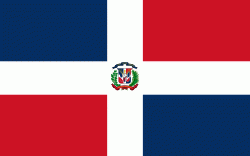Moca (Moca)
Moca is the capital of Espaillat province in the Cibao region of the Dominican Republic, and is the tenth-largest city of the country with a population of 173,442 inhabitants. Moca is located 11 miles/18 kilometers east from the country’s second-largest city, Santiago. It is divided into eight municipal districts: San Víctor, Las Lagunas, José Contreras, Juan López, El Higuerito, La Ortega, Monte de la Jagua and Canca La Reina.
The city is known as "La Villa Heroica" (Village of Heroes) due to the number of men and women from Moca who have played a major role in the Dominican Republic's history in bringing down two dictators, Ulises Heureaux and Rafael Trujillo, and bringing democracy back to the country.
Moca is home to the Corazon Sagrado de Jesus ("Sacred Heart of Jesus") Cathedral. All its pane glass windows were originally brought from Italy depicting the apostles and Jesus' path to the crucifixion. Agriculture forms the primary livelihood of the inhabitants. Plantain and yucca are main crops. Most crops are harvested by hand.
According to Emiliano Tejera, Moca means a tree that overlooks the river banks. Others claim that the word comes from the region of Mocán, a section in the province of La Vega near the river. Others claim that the word Moca is based on the coffee crop name: Mocca. According to Franklin Torres Moca is derived from an Aboriginal term which was adopted by the European settlers.
The city is known as "La Villa Heroica" (Village of Heroes) due to the number of men and women from Moca who have played a major role in the Dominican Republic's history in bringing down two dictators, Ulises Heureaux and Rafael Trujillo, and bringing democracy back to the country.
Moca is home to the Corazon Sagrado de Jesus ("Sacred Heart of Jesus") Cathedral. All its pane glass windows were originally brought from Italy depicting the apostles and Jesus' path to the crucifixion. Agriculture forms the primary livelihood of the inhabitants. Plantain and yucca are main crops. Most crops are harvested by hand.
According to Emiliano Tejera, Moca means a tree that overlooks the river banks. Others claim that the word comes from the region of Mocán, a section in the province of La Vega near the river. Others claim that the word Moca is based on the coffee crop name: Mocca. According to Franklin Torres Moca is derived from an Aboriginal term which was adopted by the European settlers.
Map - Moca (Moca)
Map
Country - Dominican_Republic
 |
 |
| Flag of the Dominican Republic | |
The native Taíno people had inhabited Hispaniola before the arrival of Europeans, dividing it into five chiefdoms. They had constructed an advanced farming and hunting society, and were in the process of becoming an organized civilization. The Taínos also inhabited Cuba, Jamaica, Puerto Rico, and the Bahamas. The Genoese mariner Christopher Columbus explored and claimed the island for Castile, landing there on his first voyage in 1492. The colony of Santo Domingo became the site of the first permanent European settlement in the Americas and the first seat of Spanish colonial rule in the New World. It would also become the site to introduce importations of enslaved Africans to the Americas. In 1697, Spain recognized French dominion over the western third of the island, which became the independent state of Haiti in 1804.
Currency / Language
| ISO | Currency | Symbol | Significant figures |
|---|---|---|---|
| DOP | Dominican peso | $ | 2 |
| ISO | Language |
|---|---|
| ES | Spanish language |















